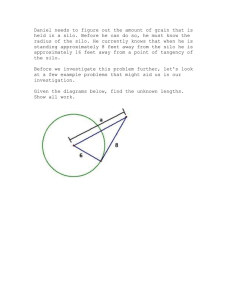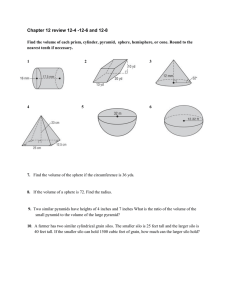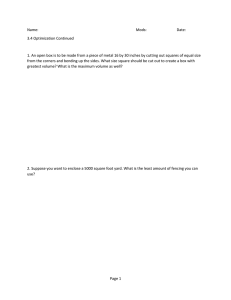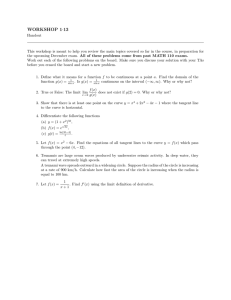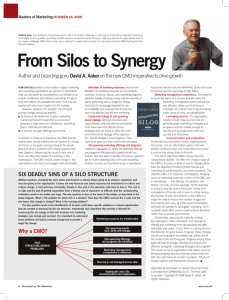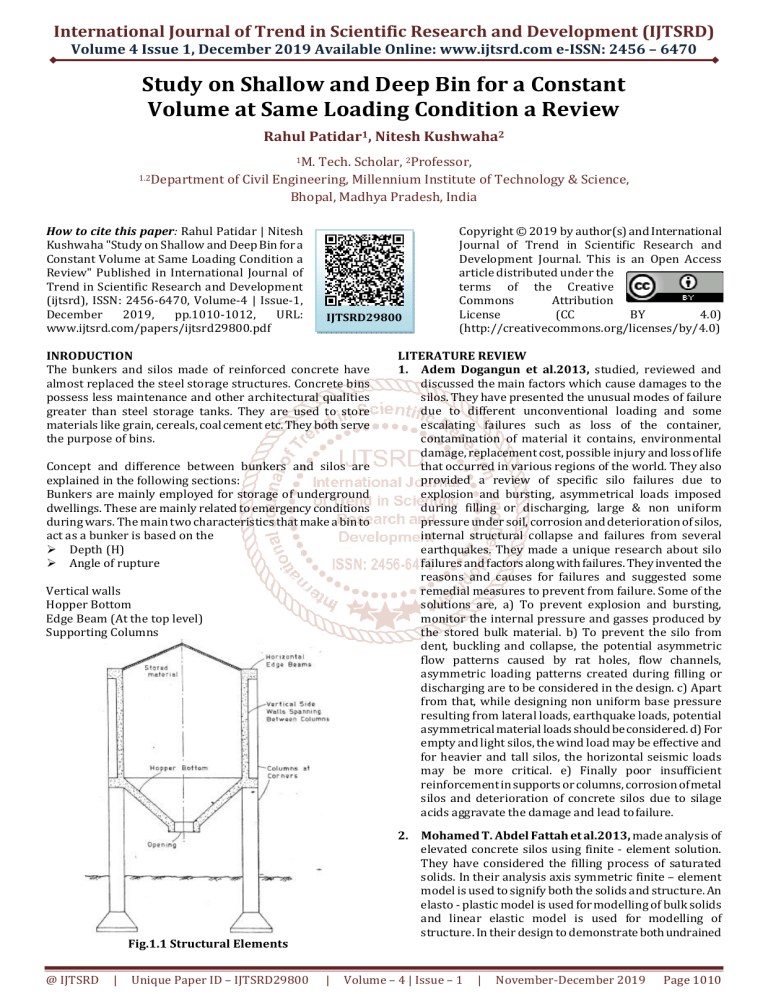
International Journal of Trend in Scientific Research and Development (IJTSRD)
Volume 4 Issue 1, December 2019 Available Online: www.ijtsrd.com e-ISSN: 2456 – 6470
Study on Shallow and Deep Bin for a Constant
Volume at Same Loading Condition a Review
Rahul Patidar1, Nitesh Kushwaha2
1M.
Tech. Scholar, 2Professor,
1.2Department of Civil Engineering, Millennium Institute of Technology & Science,
Bhopal, Madhya Pradesh, India
How to cite this paper: Rahul Patidar | Nitesh
Kushwaha "Study on Shallow and Deep Bin for a
Constant Volume at Same Loading Condition a
Review" Published in International Journal of
Trend in Scientific Research and Development
(ijtsrd), ISSN: 2456-6470, Volume-4 | Issue-1,
December
2019,
pp.1010-1012,
URL:
www.ijtsrd.com/papers/ijtsrd29800.pdf
IJTSRD29800
INRODUCTION
The bunkers and silos made of reinforced concrete have
almost replaced the steel storage structures. Concrete bins
possess less maintenance and other architectural qualities
greater than steel storage tanks. They are used to store
materials like grain, cereals, coal cement etc. They both serve
the purpose of bins.
Concept and difference between bunkers and silos are
explained in the following sections:
Bunkers are mainly employed for storage of underground
dwellings. These are mainly related to emergency conditions
during wars. The main two characteristics that make a bin to
act as a bunker is based on the
Depth (H)
Angle of rupture
Vertical walls
Hopper Bottom
Edge Beam (At the top level)
Supporting Columns
Copyright © 2019 by author(s) and International
Journal of Trend in Scientific Research and
Development Journal. This is an Open Access
article distributed under the
terms of the Creative
Commons
Attribution
License
(CC
BY
4.0)
(http://creativecommons.org/licenses/by/4.0)
LITERATURE REVIEW
1. Adem Dogangun et al.2013, studied, reviewed and
discussed the main factors which cause damages to the
silos. They have presented the unusual modes of failure
due to different unconventional loading and some
escalating failures such as loss of the container,
contamination of material it contains, environmental
damage, replacement cost, possible injury and loss of life
that occurred in various regions of the world. They also
provided a review of specific silo failures due to
explosion and bursting, asymmetrical loads imposed
during filling or discharging, large & non uniform
pressure under soil, corrosion and deterioration of silos,
internal structural collapse and failures from several
earthquakes. They made a unique research about silo
failures and factors along with failures. They invented the
reasons and causes for failures and suggested some
remedial measures to prevent from failure. Some of the
solutions are, a) To prevent explosion and bursting,
monitor the internal pressure and gasses produced by
the stored bulk material. b) To prevent the silo from
dent, buckling and collapse, the potential asymmetric
flow patterns caused by rat holes, flow channels,
asymmetric loading patterns created during filling or
discharging are to be considered in the design. c) Apart
from that, while designing non uniform base pressure
resulting from lateral loads, earthquake loads, potential
asymmetrical material loads should be considered. d) For
empty and light silos, the wind load may be effective and
for heavier and tall silos, the horizontal seismic loads
may be more critical. e) Finally poor insufficient
reinforcement in supports or columns, corrosion of metal
silos and deterioration of concrete silos due to silage
acids aggravate the damage and lead to failure.
2. Mohamed T. Abdel Fattah et al.2013, made analysis of
elevated concrete silos using finite - element solution.
They have considered the filling process of saturated
solids. In their analysis axis symmetric finite – element
model is used to signify both the solids and structure. An
elasto - plastic model is used for modelling of bulk solids
and linear elastic model is used for modelling of
structure. In their design to demonstrate both undrained
Fig.1.1 Structural Elements
@ IJTSRD
|
Unique Paper ID – IJTSRD29800
|
Volume – 4 | Issue – 1
|
November-December 2019
Page 1010
International Journal of Trend in Scientific Research and Development (IJTSRD) @ www.ijtsrd.com eISSN: 2456-6470
and drained conditions, the filling process is idealized via
multistage numerical technique. They found out that the
effect of filling process is time – dependant and excess
pore water pressure caused by filling process might
control the magnitude of internal forces. According to
their study, number of solutions can be obtained for
combination of materials, geometry and loading
conditions. They gave one key point regarding drained
and undrained condition which is the maximum tension
would be in contact with the undrained condition and the
maximum compression would be in contact with the
drained condition while designing the silo wall or hopper
for hoop forces. They also considered the permeability of
the filling material since the process is time dependant.
The results of their investigation may be helpful for field
testing program and evaluation of existing concrete silos.
3. Sachidanandam. K and Jose Ravindra Raj. B 2014,
studied the causes for failure of bunkers and silos and
illustrated them as, due to design, fabrication & erection
error, improper usage and maintenance. They have
studied about the powder flow and used that gathering in
design of silos and bunkers which can discharge the
material free from hang-up. Based on their study and
learning from many projects, they listed some practical
approach to the upcoming researchers. They are, a)
requirement of flow pattern, b) measurement of powder
properties, c) Based on the material to be handled and
operational requirements, design models should be
utilized. Also they evaluated the problems in silage juice
level which means fermented green forage fodder stored
in a silo, loading problems and measurement techniques
for effective design.
4. Suvarna Dilip Deshmukh and Rathod S. T 2014, made
a comparative study on the design and seismic behaviour
of RCC silo. They have studied about the unusual failure
modes and their causes. They have analyzed and
designed as per IS 4995, Euro code (EN 1998- 4:1999
and EN 1991-4:2006) and ACI code. For the design they
have considered static and dynamic pressure exerted by
stored materials & seismic loads. Based on their study
they have been concluded that while designing silo wall,
pressure due to seismic action must be considered. In
their analysis they found out that varying reinforcement
along depth of wall & more on the middle portion of wall
could perform well.
5. Sivabala. P et al.2015, analyzed the effect of shear wall
panels on the dynamic response of a silo. They done a
dynamic analysis of a typical silo and during that the
effect of extra plates between the columns was evaluated.
Their analysis showed significant change in the
frequency and mode shape of the structure. Also they
proved that the stability of structure increased with the
presence of extra plates between supporting columns.
Finally they concluded that by providing plates between
columns, stability of structure can be increased in
earthquake prone areas, stresses in structure can be
decreased around 40%, and displacement of structure
can be reduced around 25%.
6. Ramakrishna Vemula and Venkateswara Rao. K
2015, dealt with the cross sectional distortion
phenomenon of circular cylindrical silo using Finite
element model in ANSYS. They carried out a case study
@ IJTSRD
|
Unique Paper ID – IJTSRD29800
|
using pressure and wind load distribution based on the
recommendations of IS codes. Also they carried out a
three dimensional numerical simulation in detail on steel
and concrete silo structure. For their analysis they have
applied large internal loads internally & externally for
static, modal, harmonic and buckling conditions. They
made the following conclusions from their work. 1) The
structure might fail at the centre portion of the legs. 2)
Estimated cost of concrete reinforcement silo structure is
more than the steel structure. 3) Concrete reinforcement
structure might compete with the steel structure in many
positive aspects.
7. Rajani S Togarsi analyzed 2015, the seismic response
of reinforced concrete silo supported with shear walls
and supported on only columns with no change in
dimensions. The author modelled the structures using
Finite element method package software SAP 2000 for
soil type II located in the Zone II and considered the
conditions such as empty silo, partially filled and fully
filled with storage material. Load combinations were
based on the IS 1893:2002 (part-I). The author found out
the lateral displacement of reinforced concrete silo for
both conditions which was mentioned earlier. Conclusion
of the research was increased mass and stiffness lead to
the increased lateral displacement and silo with full filled
materials caused high lateral displacement when
compared to the partially filled silo& empty silo. Also
shear wall supported silo undergone less lateral
displacement than silo supported on only columns.
8. Nateghi. F and M. Yakhchalian 2015, investigated the
seismic behaviour steel silos with different height to
diameter ratios with granular material – structure
interaction. They have considered the complex dynamic
behaviour of silos under seismic load. For the analysis
they used Euro code, ABAQUS finite element package and
applied hypo plasticity theory to describe stress rate as a
function of stress, strain rate and void ratio. Shell
elements were used to model silo wall and solid
elements were used to model granular material. They
have applied Coulomb friction law to model the
interaction between wall & material. According to them
the seismic behaviour of silos was influenced on the
height to diameter ratio of silo
9. Ashwini Bindari and K. N. Vishwanath 2017,
analysed the effect of seismic and wind loads on steel silo
structures. They compared the steel silos and concrete
counterparts and listed the merits of steel silos such that
it has high strength per unit weight and high ductility.
Due to the ductile property the steel silo might give
sufficient warning before failure by the way of increased
deformations. They made analysis on high rise steel
building frame with braced and unbraced supports with
the help of SAP 2000 software package. For the dynamic
analysis under the selected earthquake zone V,
equivalent static method and response spectrum method
were implemented. Based on their study, they made
following conclusions, a) Base shear was more for
seismic effect when compared to wind effect. b)
Displacement of structure generally found to be reduced
by providing braced frame for supporting silo structure.
c) Braced system gave economical results compared to
unbraced system in terms of frequency and
displacement.
Volume – 4 | Issue – 1
|
November-December 2019
Page 1011
International Journal of Trend in Scientific Research and Development (IJTSRD) @ www.ijtsrd.com eISSN: 2456-6470
10. Indrajit Chowdhury and Raj Tilak 2018, suggested a
procedure to incorporate the dynamic pressure due to
earthquake in the analysis of circular silos. They carried
out this analysis using conventional Jansen’s method
with some modifications and they did parametric study
about dynamic pressure on wall of silo with different
structural configuration. They proposed new
mathematical model to apply within a design office frame
work which did not need an elaborate FEM analysis and
could well adapted in a spreadsheet or mathcad shell.
They insisted that usual ignorance of vertical component
of earthquake in structural design would encourage the
lateral dynamic pressure and should not be ignored
particularly for the huge capacity silo. Finally they
concluded that ignorance of seismic effect would
considerably under design the silo wall design
procedure.
11. Dr. Amit Bijon Dutta 2018, The demand for Storage
Structures has increased due to increase of population.
To provide storage for materials like grains, cereals, coal,
cement etc, industries would prefer the structures called
as Bins. The Bin can be termed as a Bunker whose
diameter is large when compared to its height. Similarly,
when the height of the container is larger than its
diameter it is termed as a Silo. In recent times the Steel
storage structures have replaced by the Reinforced
concrete bins because of their simple maintenance and
better architectural qualities. As per today’s scenario,
industries habitually go for single or multiple
compartments of bunkers or silos to store the
manufactured materials.
12. Dr. Kameshwari. B et al. 2019, studied the dynamic
response of high rise structures under the influence of
discrete staggered shear walls. Due to the restriction in
the architectural design to adopt shear wall, they have
introduced the new concept of discrete shear wall panels.
They have analysed the various configurations of shear
wall panel such as conventional shear wall, alternate
arrangement of shear walls, diagonal arrangement of
shear walls, zigzag arrangement of shear walls and
influence of lift core walls. Out of these five
configurations studied they found that zigzag
arrangement system might control the response to
earthquake loading and also diagonal shear wall
configuration would be effective in earthquake prone
areas. Apart from this shear walls placed along shorter
plan gave better results than that in larger plan
dimension.
OBJECTIVES
To Study the factors to be considered while design,
erection and fabrication of the same.
CONCLUSION
Silo can be preferred over bunkers.
More storage capacity of silos structure then bunker in a
given land space, bunker is prefer more land space then
silo.
@ IJTSRD
|
Unique Paper ID – IJTSRD29800
|
REFERENCES
[1] Alan W. Roberts, "Review of Silo Loadings Associated
with the Storage of Bulk Granular Materials".
[2] IS:5503(Part I)-1969, Indian Standard- “GENERAL
REQUIREMENT FOR SILOS FOR GRAIN STORAGE” ,
Bureau of Indian Standards., New Delhi, 1970.
[3] IS:875(Part-II)-1987, “Indian Standard Code of Practice
for Design Loads(other than earthquake)for Building
and Structures”, Bureau of Indian Standards, New
Delhi, 1997.
[4] IS:875(Part-III)-1987, “Indian Standard Code of
Practice for Design Loads(other than earthquake)for
Building and Structures” ,Bureau of Indian Standard,.
New Delhi, 1997.
[5] Jim Durack, (2010),"A challenge for designers of steel
silo"
[6] John W. Carson and Tracy Holmes (2003), "SILO
FAILURE:WHY DO THEY HAPPEN?"
[7] Kameshwari. B, G. Elangovan, P. Sivabala and G.
Vaisakh, “Dynamic Response of High Rise Structures
under the influence of Discrete Staggered Shear Walls”,
International Journal of Engineering, Science and
Technology, Vol.3, No.10, ISSN: 0975-5462, October
2011.
[8] Karthiga Shenbagam. N, Mahesh, Loganayagan. S, N. V.
Manjunath and A. S. Ramesh, “Studies on Economical
Design of Bunkers”, International Journal of Advanced
Research in Computer Science and Software
Engineering, Vol.4, Issue 9, ISSN: 2277-128X,
September 2014.
[9] Krishna Raju. N, Advanced Reinforced Concrete Design,
2nd ed, CBS Publishers & Distributors(P) Ltd, 2005.
[10] Krishna T. Kharjule and Minakshi B. Jagtap, “Seismic
Analysis of R.C.C and Steel Silo”, International Journal
of Computation and Engineering Research, Vol.5, Issue
7, eISSN: 2250-3005, July 2015.
[11] Maher FJ(1966), "Wind loads on dome-cylinders and
dome-cone shapes", Journal of the Structural Division,
ASCE, Vol 91(3),pp 79-96.
[12] P Patra, Non-member, A K Samanta, Member, P Ray,
Fellow," Assessment of Transverse Deformation of
Wall of Elevated RC Cylindrical Empty Silo under Wind
Load", Vol 91, pp 9-17.
[13] Prerna Nautiyal, Saurabh Singh and Geeta Batham, “A
Comparative Study of the Effect of Infill Walls on
Seismic Performance of Reinforced Concrete
Buildings”, International Journal of Civil Engineering &
Technology (IJCIET), Volume 4, Issue 4, 2013, pp. 208 218, ISSN Print: 0976 – 6308, ISSN Online: 0976 –
6316.
[14] Rish R. F (1967),"Forces in cylindrical shells due to
wind", Proc. Institution of Civil Engineers, 36, pp 791803.
Volume – 4 | Issue – 1
|
November-December 2019
Page 1012

